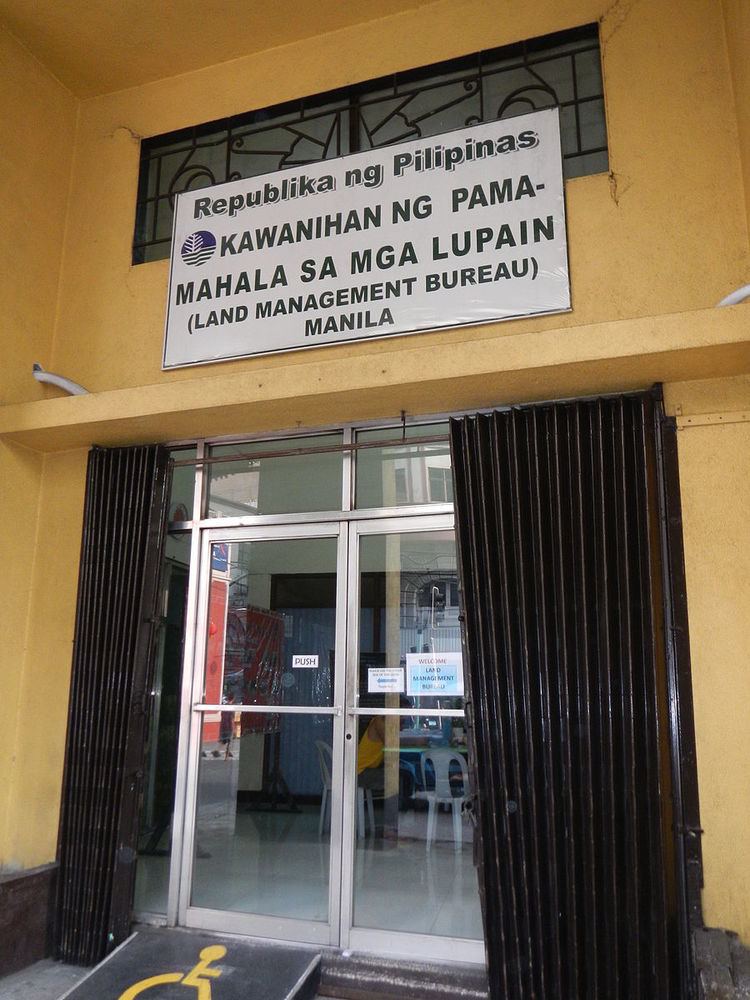Formed September 2, 1901 | Website www.lmb.gov.ph | |
 | ||
Agency executive Atty. Emelyne V. Talabis, Director Parent agency Department of Environment and Natural Resources | ||
The Philippines' Land Management Bureau (Filipino: Kawanihan ng Pamamahala sa mga Lupa, abbreviated as LMB), is an agency of the Philippine government under the Department of Environment and Natural Resources responsible for administering, surveying, managing, and disposing Alienable and Disposable (A&D) lands and other government lands not placed under the jurisdiction of other government agencies.
Contents
Promoting social equity by giving public agricultural lands to the rural masses
The Land Management Bureau (and the regional Land Management Sector) was organized on September 2, 1902 under Act 218 as the Insular Bureau of Public Lands (IBPL) with the mandate of supervising the survey and distribution of public lands in the Philippine Islands. William Tipton was appointed as the first chief of the IBPL. Under his supervision, the Bureau planned a system for the survey of the archipelago and in 1903 implemented Act 926 or the first Public Land Act of the country which became the basis of public land disposition thereafter.
Disposition under this law was done by way of homestead, free patent, sale and lease of public lands suitable for agriculture. The name Insular Bureau of Public Land was later changed by virtue of Act 1470 to the Bureau of Lands, the name became popularly known to the masses who were the direct beneficiaries of public agricultural lands for distribution.
The Bureau of Lands was likewise mandated to administer the distribution of friar lands under Act 1120. It is the first land reform program in the country as vast tract of the most productive agricultural lands were purchased by the Insular Government from religious orders and agricultural corporations and sold to actual occupants and settlers.
Cadastral survey
In order to expedite public land distribution, then Director of Lands Chas H. Sleeper introduced cadastral surveying, a public land survey that covers an extensive area, usually an entire municipality, subdividing the same into parcels for purposes of public land distribution. The first cadastral survey project (Cadastral Project No. 1) was conducted in Pilar, Bataan in November 1908. In 1913, Act No. 2259, otherwise known as the Cadastral Act, was implemented providing for a procedure of judicial adjudication of public lands. Under his leadership, he established the first Survey School in Manila High School (MHS) some time in 1908 to train Filipino surveyors. It was later transferred to the Philippine School of Trade and Arts (PSTA). The first Filipino to head the bureau was the former revolutionary general, Gen. Manuel Tinio who held office from 1913 - 1914.
Amendment of Act 926
Finding the potential impact of the disposition activity for the people and for the economy as a whole, Act 926 was revised to increase patent distribution. The second Public Land Act (Act 2874) was thus enacted on 1919 in order to hasten the disposition of public agricultural lands to the Filipinos by introducing the system of land classification and increasing the homestead area from sixteen hectares (40 acres) to twenty-four hectares (59 acres).
The Survey School of the Bureau was transferred to the University of the Philippines (UP), College of Engineering in 1925. It was also during this time that the Bureau of Lands was divided into nine inspection district and thirty-two district land offices in order to decentralize land surveying and processing of land patent application to the provinces. However, the appointment of district land officers was done by designation only among surveyors, public land inspectors, land attorneys, and clerks.
In 1936, the Commonwealth Government of the Philippines re-enacted the Public Land Act as Commonwealth Act No. 141, the third and the present public land disposition law in the country.
Post war efforts to fast-track land distribution
In 1953, the Bureau of Lands entered the era of modernization with the introduction of IBM and Remington Rand computing machines capable of handling bulk computations. The bureau became the most advanced government agency in the Philippines in terms of electronic computing. This effort was made in order to respond to the need to speed up the distribution of public agricultural lands in the rural area due to the agrarian unrest in the countryside and to reconstruct records damaged from the war. From 1950 to 1960, 1.4 million hectares of agricultural lands were distributed by the bureau, double that of the 1930-1940 period.
Devolution of functions
It was only in 1939 that the position of District Land Offices (DLOs) was formally created under Executive Order No. 246. DLOs were authorized for the first time to render decisions on important matters. Public Land Act of 1936 was enacted which remains the governing law on public lands.
Before the start of the war, the bureau was able to issue a total of 93,694 patents and had conducted a total of 289 cadastral surveys by the Bureau, the last being Cad – 289 in Manay, Davao Oriental for judicial titling.
In 1972, Republic Act No. 6516 was enacted authorizing the district land officers in every province to sign patents not exceeding five hectares thereby fully devolving the functions to the district offices. Because of the devolution, more than two million hectares of agricultural land was distributed by the Bureau of Lands from 1970 to 1980.
Reorganization of the DENR
Executive Order No. 192 organized the Department of Environment of Natural Resources (DENR) in June 1987. The new organizational setup integrated the Bureau of Lands District Land Offices with the field offices of the DENR and transformed the Bureau’s Central Office to the Land Management Bureau, which became a staff bureau. The reorganized bureau spearheaded the distribution of public agricultural lands through the Comprehensive Agrarian Reform Program (CARP) of the government distributing 1.32 million hectares to the rural community.
